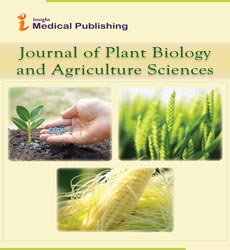Plants are Crossbred to Present Attributes
Mateus José Sudano *
Department of Geneticsand Evolution,Federal University of São Carlos, São Carlos, SP, Brazil
- *Corresponding Author:
- Mateus José Sudano
Department of Geneticsand Evolution,Federal University of São Carlos, São Carlos, SP, Brazil
E-mail: mjsudano@ufscar.br
Received date: 05 August, 2021; Accepted date: 19 August, 2021; Published date: 26 August, 2021.
Citation:Dr. Sudano M J(2021) Plants are Crossbred to Present Attributes.J Plant Bio Agric Sci Vol.5 No.6:102
Introduction
Plant reproducing is the study of changing the attributes ofplants to deliver wanted qualities. It has been utilized to work onthe nature of sustenance in items for people and creatures. Theobjectives of plant reproducing are to create crop assortmentsthat gloat novel and prevalent attributes for an assortment ofhorticulturalapplications. The most regularly addressedattributes are those identified with biotic and abiotic stressresistance, grain or biomass yield, end-utilize quality qualitieslike taste or the convergences of explicit natural particles(proteins, sugars, lipids, nutrients, filaments) and simplicity ofpreparing (collecting, processing, heating,malting, mixing,etc.).Plant rearing can be through various strategies going fromjust choosing plants with advantageous attributes for spread, totechniques that utilizeinformation on hereditary qualities andchromosomes, to more intricate atomic methods (see cultigenand cultivar).Qualities in a plant are what figure out what kindof subjective or quantitativeattributes it will have. Plant raisersendeavor to make a particular result of plants and conceivablynew plant assortments, and over the span of doing as such,limited down the hereditary variety of that assortment to aparticular few biotypes. It is rehearsed worldwide by people likegrounds-keepers and ranchers, and by proficient plant raisersutilized by associations like government establishments,colleges, crop-explicit industry affiliations or exploration focuses.Global advancement organizations accept that rearing newharvests is significant for guaranteeing food security by growingnew assortments that are higher yielding, infection safe, dryspell lenient or provincially adjusted to various conditions anddeveloping conditions. One significant method of plant rearing isdetermination, the course of specifically engendering plantswith helpful attributes and killing or "winnowing" those with lesspositivequalities. Another strategy is the purposefulinterbreeding (crossing) of intently or indirectly related peopleto deliver new yield assortments or lines with advantageousproperties. Plants are crossbred to present attributes/qualitiesfrom one assortment or line into another hereditary foundation.For instance, a buildup safe pea might be crossed with a high-yielding yet powerless pea, the objective of the cross being topresent mold opposition without losing the high return qualities.Descendants from the cross would then be crossed with thehigh-yielding guardian to guarantee that the offspring were mostsimilar to the high-yielding guardian, (backcrossing). Theoffspring from that cross would then be tried for yield(determination, as portrayed above) and buildup opposition andhigh-yielding safe plants would be additionally evolved. Plantsmay likewise be crossed with themselves to deliver innateassortments for rearing. Pollinators might be rejected usingfertilization packs. Old style rearing depends to a great extent onhomologous recombination between chromosomes to producehereditary variety. The traditional plant reproducer may likewiseutilize various in vitro methods like protoplast combination,incipient organism salvage or mutagenesis (see underneath) tocreate variety and produce crossover plants that would not existin nature. ification needed]Homozygous plants with beneficialcharacteristics can be delivered from heterozygous beginningplants, if a haploid cell with the alleles for those attributes canbe created, and afterward used to make a multiplied haploid.The multiplied haploid will be homozygous for the idealattributes. Moreover, two distinct homozygous plants made inthat way can be utilized to deliver an age of F1 half breed plantswhich enjoy the benefits of heterozygosity and a morenoteworthy scope of potentialattributes. Consequently, anindividual heterozygous plant picked for its positiveattributescan be changed over into a heterozygous assortment (F1crossover) without the need of vegetativeproliferation yet asthe consequence of the cross of two homozygous/multipliedhaploid lines got from the initially chosen plant. Plant tissuerefined can create haploid or twofold haploid plant lines andages. This chops down the hereditary variety taken from thatplant species to choose for positivequalities that will build thewellness of the people. Utilizing this technique diminishes therequirement for reproducing numerous ages of plants to get anage that is homogenous for the ideal qualities, consequentlysaving a lot of time over the regular form of a similar cycle.
Open Access Journals
- Aquaculture & Veterinary Science
- Chemistry & Chemical Sciences
- Clinical Sciences
- Engineering
- General Science
- Genetics & Molecular Biology
- Health Care & Nursing
- Immunology & Microbiology
- Materials Science
- Mathematics & Physics
- Medical Sciences
- Neurology & Psychiatry
- Oncology & Cancer Science
- Pharmaceutical Sciences
